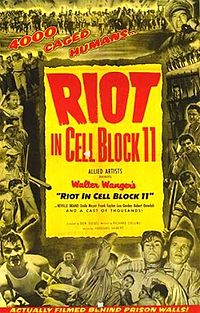
RIOT IN CELL BLOCK 11
US, 1954, 80 minutes, Black and white.
Neville Brand, Emile Mayer, Frank Faylen, Leo Gordon, Robert Osterloh, Whit Bissell.
Directed by Don Siegel.
Riot in Cell Block 11 is one of several films about prisons from the US in the 1950s – and still relevant throughout the succeeding decades. Another film was Inside the Walls of Folsom Prison of 1951.
Producer Walter Wanger spent some time in jail and was horrified at the life in the prisons. He collaborate with writer-director Richard Collins and director Don Siegel to produce this film. It is set in a prison, focuses on the riots, the cells, the yard and the warden’s office. The warden, Emile Meyer, is sympathetic to the complaints of the prisoners. They are led by Neville Brand. Whit Bissell is the threatened guard. There is also political interference and an attempt to persuade the governor to sign the reforms. While he does so, the end is pessimistic because the State Legislature overturns the governor’s signature.
The film is in crisp black and white, has lots of long shots of prisoners in the yard, giving the impact of the enormous prison as well as the life of the prisoners.
Don Siegel had made a number of films and television programs up to this time and continued to do so until the late 1960s when he broke through with such films as Madigan and then directed The Beguiled, Dirty Harry, Charlie Varrick and The Shootist.
1.The impact of the film? Prison life? The need for prison reform? The relevance in the 1950s? The same complaints in succeeding decades?
2.The black and white photography, the locations in the prison, the yard, the cells, the blocks, the warden’s office? Authentic atmosphere? Musical score?
3.The initial comments on prison reform, on the conditions of the prisoners, on their treatment as cons, the uniforms, the mixture of psychopaths with ordinary prisoners?
4.Dunn, his linking up with the Colonel? Leading the riot? Taking the guards? The cross-examination of Snader and the later threats to his life? Overcoming the guards? Taking Cell Block 11? The sympathy of the other prisoners, the riot in the dining room, the other cell block and the taking of the guards?
5.Dunn, his mental state, articulate? His wanting reforms? His power of persuading the men? Speeches? Action? His reliance on Carnie? The Colonel and the drawing up of the petition? His leadership, the clash with the angry prisoner, his being wounded? Handing over to Carnie? Carnie and his violence against the warders, the threats to Sanader? Dunn coming out, taking over again? The negotiations? The threat of the explosives to open up the cell block? The phone calls, the deals, the threat of retaliation if a prisoner was killed? The final victory?
6.The warden, wanting reform, the newspaper journalists? The clash with Haskell and the politicians? On the phone, his decisions? Haskell and his wanting to put explosives in the wall? His wanting to hand over at that stage? His being correct? Persuading the governor, the signature?
7.Haskell, political, harsh, wanting to bomb the cells? Regardless of risk to life? His not wanting the governor to sign? The governor, his being persuaded?
8.Carnie, his brutality? The Colonel? His wanting peaceful means, writing the petition? Dunn attacking him and putting him on the wall with the warders?
9.The reporters, their comments, information? Photographs?
10.The prisoners, the variety of crimes? The riots, looting?
11.The final deal? Their wanting to read it in the paper? The irony of Dunn going to the warden? The Legislature overturning the resolutions? Dunn and his being tried for leading a riot? Carnie taken to the mental institution? The Colonel getting his parole?
12.The use of film for this kind of social awareness, social persuasion?